Related Research Articles

Bihar is a state in Eastern India. It is the third largest state by population, the 12th largest by area, and the 15th largest by GDP in 2021. Bihar borders Uttar Pradesh to its west, Nepal to the north, the northern part of West Bengal to the east, and Jharkhand to the south. Bihar is split by the river Ganges, which flows from west to east. On 15 November 2000, southern Bihar was ceded to form the new state of Jharkhand. Only 11.27% of the population of Bihar lives in urban areas as per a 2020 report. Additionally, almost 58% of Biharis are below the age of 25, giving Bihar the highest proportion of young people of any Indian state. The official language is Hindi, which shares official status alongside that of Urdu. The main native languages are Maithili, Magahi and Bhojpuri. But there are several other languages being spoken at smaller levels.

The All India Majlis-e-Ittehadul Muslimeen is an Indian political party based primarily in the old city of Hyderabad, It is also a significant political party in the Indian States of Telangana, Maharashtra, Uttar Pradesh, Tamil Nadu and Bihar.
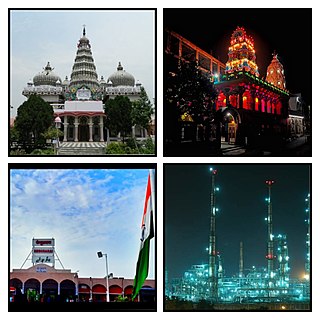
Begusarai is the industrial and financial capital of Bihar and the administrative headquarters of the Begusarai district, which is one of the 38 districts of the Indian state of Bihar. The district lies on the northern bank of the river Ganges in the Mithila region of India.

Sone River, also spelt Son River, is a perennial river located in central India. It originates near Amarkantak Hill in Pendra, Chhattisgarh and finally merges with the Ganges river near Maner in Patna, Bihar. The Sone River is the second-largest southern tributary of the Ganges after the Yamuna River. India's oldest river bridge Koilwar Bridge over Sone River connects Arrah with Patna. Sone river is famous for its sand across country. Multiple dams and hydro-electric projects run on its course towards the Ganges.

Chhath is an ancient Indo-Nepalese Hindu festival, native to Nepal and East India. It is celebrated especially in the Indian states of Bihar, Jharkhand, and Eastern Uttar Pradesh; and the Nepalese Autonomous provinces of Koshi, Lumbini, and Madhesh. In the major northern urban centres, hundreds of thousands of Nepalis and East Indians celebrate it in cities including Kathmandu Valley, Delhi, Mumbai and Calcutta. Bharat-Nepal Maitri Chhath Ghat on the bank of Dhouns river at Indo-Nepal Border areas near Madhwapur-Matihani semi towns is a popular Chhath Ghat in the Mithila region where huge number of devotees from the both countries gathered to perform the rituals of the Puja collectively. During Chhath Puja, prayers are dedicated to the solar deity, Surya: to show gratitude for bestowing the bounties of life on Earth and to request that certain wishes be granted.
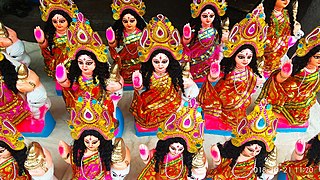
Sharad Purnima is a religious festival celebrated on the full moon day of the Hindu lunar month of Ashvin, marking the end of the monsoon season. The full moon night is celebrated in different ways in various cultural regions across Indian subcontinent.

Gangaur is a Hindu festival celebrated in the Indian states of Rajasthan, Haryana, the regions of Malwa, Nimar regions of Madhya Pradesh and the Braj and Bundelkhand regions of Uttar Pradesh. It is also celebrated in some parts of Gujarat and West Bengal. A variation of same festival known as Chaitra Gauri Vrat is observed on the same day in the states of Maharashtra and northern Karnataka. Another variation called Saubhagya Gauri Vratam is observed in the states of Telangana and Andhra Pradesh.
Daudnagar is a town and the subdivisional headquarter of Daudnagar Subdivision in Aurangabad district in the state of Bihar, India under the Magadh division. Until 1991, there was only one Subdivision in the Aurangabad district: Aurangabad Sadar. On 31 March 1991, one other subdivision, Daudnagar, was created. Daudnagar is a 200-year-old historical city and its living proof is Daudnagar has an old historical fort situated on the eastern bank of the Son River. National Highway NH139 which connects Jharkhand's Palamu district to Patna, passes through the town.
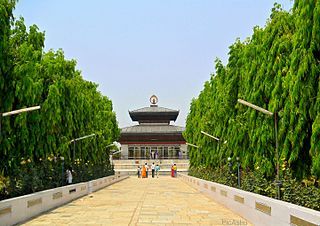
Mithila, also known as Tirhut, Tirabhukti and Mithilanchal, is a geographical and cultural region of the Indian subcontinent bounded by the Mahananda River in the east, the Ganges in the south, the Gandaki River in the west and by the foothills of the Himalayas in the north. It comprises certain parts of Bihar and Jharkhand of India and adjoining districts of the Koshi Province, Bagmati Pradesh and Madhesh Province of Nepal. The native language in Mithila is Maithili, and its speakers are referred to as Maithils.
Banjari is a small town at the south-western tip of Bihar state, India. It is located on the Sone River, the largest of the Ganges' southern tributaries, in Rohtas district. It is framed by the Kaimur mountain range, to the south-east of Sasaram.

Mithila culture or Maithil culture refers to the culture which originated in the Mithila region of the Indian subcontinent. Mithila comprises Tirhut, Darbhanga, Kosi, Purnia, Munger, Bhagalpur and Santhal Pargana divisions of India and adjoining provinces of Province No. 1, Bagmati Pradesh, and Madhesh Province of Nepal.
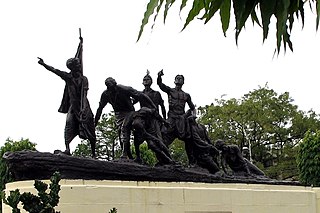
The Martyrs' Memorial, also known as Shaheed Smarak, is a life-size statue of seven young men who died in the Quit India movement, to hoist the national flag on the (now) Secretariat building. The foundation stone of Martyr's Memorial was laid on 15 August 1947, by the governor of Bihar, Mr. Jairam Das Daulatram in presence of Premier of Bihar Shri Krishna Sinha and his deputy Anugrah Narayan Sinha. The sculptor Devi Prasad Roychoudhury built the bronze statue of the seven students with the national flag. These statues were cast in Italy and later placed here.

Bhojpur is a ethnolinguistic and cultural area in the Indian subcontinent where the Bhojpuri language is spoken as a mother tongue. The Bhojpuri region encompasses parts of the Indian states of Bihar, Uttar Pradesh, and Jharkhand, and the Madhesh, Gandaki and Lumbini provinces of Nepal.

Jitiya is a three-day-long Ancient Hindu festival which is celebrated from the seventh to ninth lunar day of Krishna-Paksha in Ashvin month. It is celebrated mainly in Nepal and the Indian states of Uttar Pradesh, Bihar and Jharkhand. Mothers fast for well-being of their sons. It is celebrated for eight days in Jharkhand from first moon day to eight moon day in the first half of Ashvin month.
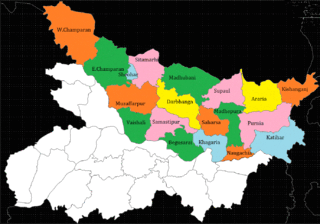
North Bihar is a term used for the region of Bihar, India, which lies north of the Ganga river.
Bapudham Motihari Railway Station is a major railway station in Motihari through which 2 lines pass one towards Muzaffarpur and other towards Sitamarhi via Sheohar, it lies in the headquarter city of East Champaran district of Bihar. Its station code is BMKI. The station mainly consists of four platforms and acts as the main station in the city of Motihari, which is being developed under 'The Amrit Bharat Station Scheme' and to celebrate 150 years of Mahatama Gandhi. In February 2022, the Indian Railways had planned to set up a railway station Development Corporation (RSDC) that would work on improving the major railway stations, including Bapudham Motihari, by building and improving passenger amenities.[4] Under the development scheme, major development works are going on Bapudham Motihari. Separate air conditioned waiting lounge, free WiFi facility, IRCTC food court and many facilities are going to be available on Bapudham Motihari at the end of 2024. To enhance the security of this station, a metal detector and baggage handling system will be installed soon.

Bharpura Pahlejaghat Junction, station code PHLG, is a railway station in Sonpur division of East Central Railway. Bharpura Pahlejaghat Junction is located in Sonpur city in Saran district in the Indian state of Bihar. It is located on the north end of Digha–Sonpur rail–road bridge, while Patliputra is on the south end of the bridge. Pahleja Station is 3.81 km from Sonpur and 11.46 km from Patliputra. It is connected to Sonpur on its east side and Parmanandpur station on its west side. In June 2017, a 20 kW roof top hybrid solar plant with 20% storage facility installed and commissioned at Pahaleja Ghat railway station.

Deo Sun Temple is a Hindu temple in Bihar, India. The temple is a solar shrine, dedicated to Surya, the sun god, for Chhath Puja. The temple is located in Deo Town, Aurangabad. The Temple is unique as it faces west, the setting sun, not the usual rising sun. It is considered to be one of the most sacred places for sun worshiping and Chhath Puja.

The 2024 Indian general election was held in Bihar in all 7 phases from 19 April to 1 June to elect 40 members of the 18th Lok Sabha, with the results declared on 4 June.
Dhouns is the name of a river that flows on the plains of the Mithila region of Nepal and India. It is the part of Adhwara group of rivers flowing from Nepal to the western part of the Madhwapur block area in the Madhubani district of Bihar in India.
References
- ↑ "Jivitputrika Vrat 2022 – Jitiya 2022 Date In Bihar". 21 July 2022.
- ↑ "Jitiya Vrat 2022: बिहार-यूपी में कब है जितिया व्रत, जानें काशी और मिथिला पंचांग के अनुसार सही डेट व टाइम". 15 September 2022.
- ↑ "Jitiya – A Festival Of Women". 17 August 2020.
- ↑ "Jivitputrika Vrat 2020: जीवित्पुत्रिका व्रती महिलाएं आज खोलेंगी व्रत, जानें पारण करने के लिए हर एक शुभ समय और विधि". 11 September 2020.
- ↑ "My Mati: आसिन कर अठमी के जितिया गड़ाय रे" (in Hindi). Prabhat khabar. 16 September 2022. Retrieved 9 October 2022.
- ↑ "Assam flood situation improves marginally; toll rises to 39". The Hindu. Press Trust of India. 2024-06-22. ISSN 0971-751X . Retrieved 2024-06-22.
- ↑ "Bangladesh: Floods and Landslides - Jun 2024 | ReliefWeb". reliefweb.int. 2024-06-22. Retrieved 2024-06-22.
- 1 2 "Dozens of children drown during Hindu festival in India". Reuters. 26 September 2024. Retrieved 26 September 2024.
- ↑ "46 Drown, Including 37 Children, During 'Jivitputrika' Festival In Bihar Districts". NDTV.com. Retrieved 2024-09-26.
- 1 2 Bhelari, Amit (2024-09-26). "46, including 37 children, drown across Bihar during Jitiya festival". The Hindu. ISSN 0971-751X . Retrieved 2024-09-26.
- 1 2 "37 children among 46 drown during 'Jivitputrika' festival across Bihar". India Today. 2024-09-26. Retrieved 2024-09-26.
- ↑ "46 People Drown During Hindu Festival In India: Govt Official". Barron's. 26 September 2024. Retrieved 2024-09-26.